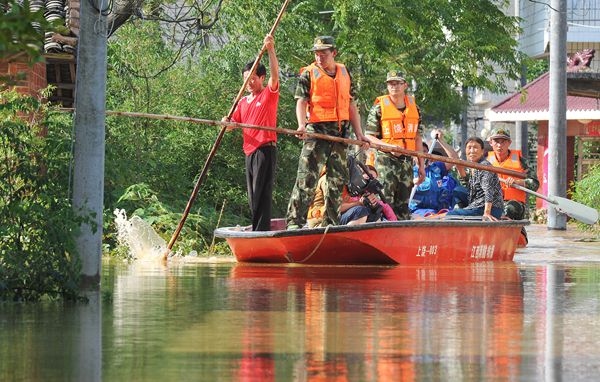
Firefighters search for people stranded in the floods in Poyang county, Jiangxi province, on Tuesday. WANG QI/CHINA DAILY
Weeks of torrential rain have caused a series of devastating floods in many parts of China. With economic losses soaring, the impact will be felt on GDP growth. The estimated loss of more than $44.7 billion makes this year's floods in China one of the costliest non-U.S. weather disaster on record. Only the 1998 floods, which caused a loss of about $40 billion (at 2016 dollar rate), were the same damaging.
Economic growth is very sensitive to adverse impacts on roads, railways and supply disruptions, which can result in shortages. As transport infrastructure is paralyzed or impaired, factories close their doors in industrial provinces, along with offices in post-industrial cities.
Fruit and vegetable prices usually rise in flood-affected areas, where the government now closely monitors prices and implements price controls, if needed. In June, the consumer price index grew 1.9 percent year-on-year. Pork prices played a major role in annualized price increases, adding some 0.7 percentage points to the headline figure. This is not surprising as the seven provinces worst hit by the floods account for more than one-fourth of all hogs in China.
Flooding patterns reflect monsoon seasons. Heavy rains in China occur along the seasonal meiyu ("plum rains") front that extends from East China to the Pacific south of Japan. Associated with the southwest monsoon, these rains typically affect southeastern China from mid-May to mid-June and northern China during July and August.
Severe floods tend to have a substantial impact on agricultural output, which is reflected by the CPI, because of heavy food weightings in the inflation basket. Analysts anticipate flooding to raise consumer prices in July and August by 0.2 percentage points, which would cause price levels to exceed 2 percent.
Rainfalls are particularly heavy in the summer following an El-Niño event, as in 1998 and this summer. Seasonally, heavy rainfalls tend to amplify downside risks, which often have a negative impact on economic growth in the third quarter, unless the government chooses to intervene with stimulus measures.
Indeed, a longer-term Keynesian stimulus can boost post-flood construction support repairs and rebuilding. If 1998 is any indication, July and August could suffer adverse impacts, which could be offset by a rebound in September.
Recurring floods increase the vulnerability of the poor, particularly small farmers. Since the 1998 floods, there has been great progress in adaptation to weather shocks, while government subsidies support agricultural insurance in China. Moreover, climate adaptation has been incorporated into the national agriculture development program.
Yet reinforcing agricultural resilience is like trying to repair a plane's engine after the take-off. With weather shocks becoming increasingly severe, agricultural insurance premiums are soaring and national initiatives have to cope with adverse global trends.
In addition to agricultural resilience, sustainable urbanization would go a long way not just to support adaptation but also to contribute to mitigation.
To fight flooding and mitigate its costs, the government is conducting sponge city pilots in some 16 major urban centers, including Beijing and Shanghai. The goal is to retrofit existing drainage systems or build sponge cities, which can control floods and conserve water.
Adaptation can only respond reactively to adverse effects. In contrast, mitigation can proactively reduce the costs of extreme weather events. That requires sustainability, especially sustainable building construction, climate change mitigation, agricultural resilience-and sponge cities.
Necessity is the mother of invention. As extreme weather events are becoming a more habitual phenomenon, China is likely to pioneer bold and ambitious experiments toward sustainable economic development.
The author Dan Steinbock is a guest fellow at Shanghai Institutes for International Studies.


















































